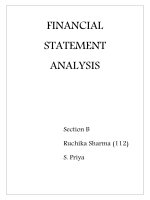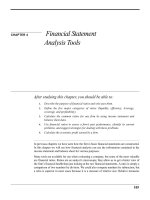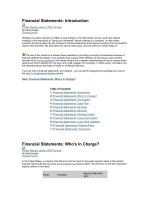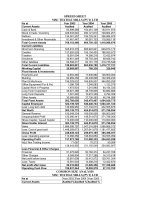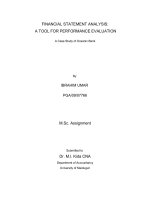FINANCIAL STATEMENT ANALYSIS 2
Bạn đang xem bản rút gọn của tài liệu. Xem và tải ngay bản đầy đủ của tài liệu tại đây (10.75 MB, 72 trang )
1
FINANCIAL STATEMENT ANALYSIS
FINANCIAL STATEMENT:
Financial Statement, as normally understood, refer to a set of reports and
schedules which an account prepares at the end of a period of time for a business
enterprise.
According to Smith and Ashburne, financial products are the end products
of financial accounting, prepared by the accountant, that support to reveal the
financial position of the enterprise, the result of its recent activities and an analysis
of what has been done with the earnings.
There are six basic financial statements of special importance. They are:
1. The Income Statement (Profit and Loss A/c)
2. The Position Statement (Balance Sheet)
3. The Funds Flow Statement (Sources and Application Statement)
4. The Cash Flow Statement
5. The Statement of Retained Earnings
6. Schedules
1. INCOME STATEMENT: The Income Statement, also called as the Profit &
Loss account, is the accounting report which summarizes the revenues, expenses
and the difference between them for an accounting period. The construction of an
Income Statement is accordance with the concepts of Accrual, Accounting period,
Matching, Materiality and Realization there is no statutory format in which the
Income Statement is to be presented, except for Banking and Insurance companies.
However Sec. 211 of the Companies Act, 1956 prescribes the contents to be
disclosed in this statement.
2
2. POSITION STATEMENT: The Position Statement or Balance Sheet shows
the financial status of a business at a given point of time. All the assets owned by
the business and all the liabilities and claims it owes to outsiders and owners are
listed. The Balance Sheet must always be in balance i.e. the total assets should
always be equal to total liabilities. The Balance Sheet of a joint stock company
must be prepared as per Part I of Schedule VI of Co. Act. Separate statutory
formats exist for the preparation of the Balance Sheet of Banking and Insurance
Companies.
3. FUNDS FLOW STATEMENT: The term 'fund' normally means working
capital. The funds flow statement reveals the sources from which funds are
received and the uses to which these have been put. It is a valuable tool to analyze
the changes in the financial condition of the business between two periods and
helps the management in policy formulation and performance appraisal.
4. CASH FLOW STATEMENT: The Cash flow statement is a statement of
changes in the financial position of a firm on 'Cash bases. It is very much similar to
the 'Funds Flow' statement, except that the cash flow statement lays emphasis on
cash changes only.
5. STATEMENT OF RETAINED EARNINGS: The statement of retained
earnings, also known as the Profit and Loss Appropriation Account, is a
continuation of the Income Statement. It reveals the Profits freely available, after
deduction of all expenses, including tax, and how it has been appropriated. The
balance after all appropriations is shown in the liabilities side of the Balance Sheet.
Thus, the statement and the Balance Sheet.
3
6. SCHEDULES: Schedules are statements which describe the summarized
information presented in the Income Statement and the Balance Sheet in greater
detail. Schedules are a part of the financial statements, and enable a better
understanding of the financial position of a business.
FINANCIAL STATEMENT ANALYSIS:
The significance of financial statement lies not in their preparation but in
their analysis and interpretation. Analysis and interpretation of financial statements
involves a study of relationship among various financial factors and to judge their
meaning and significance. The financial analyst must understand the plans and
policies of management, determine the extent of analysis, reorganize data available
as per requirements, establish relationship among financial figures and make
interpretations in a simple and unbiased way.
Types of Analysis:
The process of analysis may be classified based on the nature of information used
and on the basis of 'methodology' of operations.
1) On the basis of Nature of Information used:
a) External Analysis: The information used is that which is freely available to
anybody. Published Financial Statements are an example of such
information. There is no access to internal records of an organization. With
increasing emphasis on disclosures in recent times, the quality of external
analysis is likely to improve in the future.
b) Internal Analysis: The source of information is Internal Analysis is the
internal or unpublished records and books. Such analysis is undertaken for
use of management or for other internal needs of the organization.
4
2) On the basis of Methodology of Operations:
a) Horizontal Analysis: It involves analysis and review of financial
statements pertaining to a number of years. An attempt id made to identify
the periodical trend of various items in the financial statements. Percentage
increase/decrease is calculated for all such items. Alternatively, a base year
is fixed and figures pertaining to other years are indexed to that of base
period. It is also known as 'dynamic' analysis or 'trend' analysis.
b) Vertical Analysis: Vertical Analysis involves analyzing a single set of
financial statement, by expressing various items of the statement as a
percentage of a particular item. Quantitative relationship is established
amongst various items at a particular data. It is also known as 'Static'
analysis or 'Structural' analysis.
TYPES OF FINANCIAL STATEMENT:
The following methods of analysis are generally used:
I. Comparative Statements
II. Common Size Statements
III. Ration Analysis
IV. Trend Analyses
5
NEED AND IMPORTANCE OF FINANCIAL STATEMENTS:
To determine the legality of dividends.
As a guide to wise dividend action.
As a basis for the granting of credit.
As information for prospective investors in an enterprise.
As a guide to the value of investment already made.
As an aid to government supervision.
As a basis for price or rate regulation.
As abases for taxation.
6
OBJECTIVE&METHODOLOGY
The financial analysis provides valuable insight into a firm͛s performance financial statement of
an organization has given for a particular period and its financial positions at the end of the
period. There by themselves will not help people to conclude whether financial performance of
the organization is good/bad. the statement given only the figure further analysis and
interpretations of these figure is better. Managers, investors and all employees some from of
this analysis at the beginning point for their financial decision making investors use financial
analysis in deciding whether or not to end their provides managers with measurement of law.
the company͛s competitions industry. The study is undertaken to present financial performance
analyst of S.P.M Ltd.
OBJECTIVES OF STUDY
The present study has the following objectives
y To study the present financial position of the concern
y To observe the trends in rations
y To examine the operational performance of the organization
y To analyses the significance of fund flow, cash flow and various financial ratios.
y To offer some suggestions in the right of analysis made to strengthen the
financial position of the organization.
7
LIMITATIONS OF THE STUDY
y Lack of the awareness a bout the projet.
y Customers are procrastinating the things many times.
y Most of the customers already have LIC policies
y Competition from other market players
y Some do not trust private insurance
y Some customers are not ready to give details due to fear of phone call me ssages.
y Although ICICI PRUDENTIAL has good return linked products, but convincing of
customers is difficult because of high premium.
y Most of the customers already have LIC policies .
y There ͚re lots of thetas in the mind of customers towards these private
companies.
y Competition from other market players.
y Time is one of the barriers for generating leads
y Customers are busy
8
CHAPTERISATION:
The entire study is dividing into four chapters. They are
1. It deals with the introduction
2. It deals with Company Profile
3. It deals with theory of financial statement analysis
4. It deals with conclusions and suggestions.
It deals with bibliography.
9
COMPANY PROFILE
ABOUT THE ORGANISATION:
THE SIRPUR PAPER MILLS LTD., marked the year 1938 for its
establishment, in 1942 under the management of "M/s. Hyderabad
Construction Company limited", it commenced production with a capacity of
14.0 M.T. per day.
In 1953 M/s. BIRLA BROTHERS were entered with management of
company with the change in the management the expansion programmed of
the mill started in a big way and by 1955 the production increased from 15
tones/day to 50 tones/day A third paper machine of 50 tones/day to 50
tones/day. A third paper machine of 50 tones/day increased to production to
100 tones/day by 1959 paper machine No,4 was installed in the year 1966
with a capacity of 10.0 Mega Tonnes per day, Later a Board machine with a
production capacity of 60.0 M.T per day was installed in the year 1974. In
1976 paper machine No.5 was started with production capacity of 10 M.T per
day.
At present the mill produces on an average of 220 Tonnes per day paper
and board of 7 paper machines. The product is located in SIRPUR
K.AGHAZNAGAR District Adilabad of Andhra Pradesh. Covering
approximately 100 acres or more of area by the plants in the company's land.
The approximate company's land in 696 acres. Present Installed Capacity
83.550 MT/year of Paper & Board & Operating 95% plant utilization level.
The Company's Turnover is Rs.180Crores. To improve the operational
efficiency of the plant to conserve the resources and contain & control pollution
10
the Company installed BHEL Recovery Boiler, Two, and FBL Boilers, Full
Hedged W.T, Plant and many of the equipments
THE PRODUCTION HAS INCREASED IN THE SECOND PHASES:
Paper machine no. 2 was commissioned in the year 1953 -30 TPD.
A new paper machine no. 3 with the capacity of 60 MT/D was
commissioned in the year 1959.
Installed another machine no. 4 of 10 MT/D production capacities in
1966,
A 60 MT/D, production capacity of board machine was started in the year
1974.
Another 10 MT/D production capacity paper machine No. 5 was
commenced in the year 1976.
7
th
machine of 68 MT/D capacities was installed and commenced on
21 March 2002.
The installed capacity of the mill today is 83,550 MT, in the financial
year 2002-03 the company has achieved its highest annual production of
77,974 MT, The total share capital of SPM Ltd is Rs.8,34,55,980 and its
present face value of the share is Rs.10. In the financial year 2000-01 the
company has achieved its maximum net profit of Rs.1621.17 lacks.
11
THE COMPANIES PRESENT PRINCIPAL BANKERS ARE:
Central Bank of India.
State Bank of Hyderabad.
Bank of Borada.
Andhra Bank.
THERE ARE 10 DIRECTORS FOR THE COMPANY INCLUDING CHAIRMAN. THEY
ARE:
Ranjan Kumar Poddar, Chairman
Sundaresan Vice Chairman
S.K. Khare, Executive Director
Devasish Poddar, Director
Sudhir Jalan
M.S. Rajajee
T.S. Appa Rao
Laxminiwas Sharma
12
P. Vaman Rao
Utsav Pari
GENERAL:
The paper is made of cellulose fibres. Cellulose is an organics material
of fibrous nature. It occurs in all woody materials mixed with gums, resins
and lignin. Cotton is the present from cellulose. In paper making, cotton is
also used for good quality for paper. But it is costly and not available in
plenty because it is required for textiles also. Therefore major source of
paper making cellulose is obtained from woods, grass, cereals straws and
bags. The percentage of cellulose and hemicelluloses content in different
materials are 65%-75%. In India bamboo raw material for paper making.
The main source of fibrous raw materials for SIRPUR PAPER MILLS are
bamboo, government reserve forest spread over 1650 sq km and hardwood
from private plantation through Andhra Pradesh Forest Development
Corporation.
RAW MATERIAL:
The source of the main raw material Bamboo is from Andhra Pradesh
Government Forest and Hard Wood from social forest. Apart from Bamboo
the raw materials consumed by "S1RPUR PAPER MILLS LTD" are
Casuarinas, Bo, Subabul, Eucalyptus and other local hard wood, Bamboo,
imported pulp and waste paper are the major raw materials used. The main
13
constituents present in the wood in cellulose and micelulloses (fiber
composition) which is used for paper manufacturing Bamboo is obtained
from forests spread out in the Northern and Eastern parts of
Andhra Pradesh in the District of Adilabad, Karimnagar. Khammam and
Warangal. The company continued to lay emphasis on obtaining basic
conventional raw materials and has motivated fanners under the various forestry
schemes. The S.P.M. Ltd receives higher qualities of Bamboo as under the
lease Agreement with Government of Andhra Pradesh.
The 75 tones/hour capacity Fluidized Bed combustion (FBC) Boiler
enabled the company to use cheaper, Low Grade Coal with higher ash content
thus reducing the dependency on erratic APSEP Power supply and also reducing
energy cost. There are total 8 coal fired boilers in the mills i.e. Six New
Boilers and two FBC Boilers cinder and fly ash are the waste material that is
generated from FBC Boilers. To improve process economy- efficiency, product
quality and new process developments, the company's research and
development activities are carried out. The company had the financial
assistance from financial institutions like IDBI, ICICI, IFCI and UIT around
10Crores from above mentioned Institutions, The SIRPUR PAPER MILLS
LTD is constantly vigilant to its duty of maintaining clear environment of
mills, site and neighborhood. Full fledged effluent treatment plant in operation
to give clear effluent discharge as per Government specification, The Sirpur
Paper Mills Ltd. is also engaged in community development activities like
Construction of Drinking Water Wells, Community Halls, and School Buildings
etc. It is also engaged in welfare activities by giving monthly aid to some of the
school's, In addition to the monthly aid to the school the management is
conducting free eye camp, Health camp, Organizing Social and Religious
Functions. Maintenance of Hospitals and water supply to some residential
wards of SirpurKaghaznagar.
14
In the year 1986 "The HRD Training Center
1
' was started training
programmed on worker Development and productivity orientation is being
conducted for the Development of workmen. The company also allows
undergoing in plan training of various students of different disciplines like
Personnel, Finance, Marketing, Engineering, Computer's etc, of various
colleges. The Company has a well established IT facilities and information
support is made having HP 9000 computer system which is operational in 20
applications areas for better integration of increased service capabilities the
company has further planned to introduce "Real Time
1
' Technology Enterprise
Resource Planning (ERP), SAP and it is under implementation.
GENERAL PRODUCTION PROCESS OF SPM LTD:
The S.P.M.L is divided into five process departments. They are as follows:
Pulp Mill
Stock Preparation
Paper Machine
Finishing House
Power Block
PULP MILL:
Pulping is essentially the separation of the cellulose fibers in the raw
materials from lignin, a phenol substance that is the bond with the fiber. The
pulping stage being linked to the nature of raw materials utilized as well as
15
characteristics of the end product is the most critical and employees a variety of
mechanical process varies from 85 -95% as a percentage of wood
utilized and such process are mainly used for the manufacture of News Print.
Chemical process generally yield 50-65% of pulp as percentage of wood
utilized and are employed for the manufacture of high strength Kraft or writing
and printing papers.
The raw materials like bamboo and hardwood are simultaneously assed
to chipper house in the ratio of 85% and 15% through conveyor. It is cut in to
pieces of size between 3mm to 45mm than it is allowed to pass through
vibrating screens and piece of size above 45mm is rejected to Re-chippers
from the chipper house the chips are passed to digester house and the
cooking material passes to blow tank and then to knitters. In Knitters cooked
chips are stored and redirected to digester house and then come to the
washing screens.
STOCK PREPARATION:
After Screening and cleaning to remove unwanted matter, followed
by bleaching (if it undesired to produce bleached varieties) the pulp is subjected
to treatment in heaters and refiners for disintegration into individual fibers.
The 'Stock' a term used to describe the dilute suspension of fibers in water
utilized to produce a sheet of paper, in prepared by blending different grades of
pulp and mixture of additives to secure the desired properties of the end
product.
THE PAPER MACHINE
:
16
At the 'Wet end' of the paper machine, the head box controls the flow
of stock, which is passed over a fine wire mesh (referred to as the 'wire') to
form the sheet of web of paper, while the water is simultaneously drained. The
paper web is then compressed against a felt to squeeze out the remaini ng
water and passed through a series of steam heated drying cylinders (the 'dry
end¶) to complete the extraction of water, followed by calendaring to achieve
surface finish.
FINISHING
:
This is the term which refers to preparation of the paper reel for
marketing and covers a series of operations such as slitting and rewinding of
large reels into smaller ones, sheet cutting and packing. Power Block the
Primary function of the power block is supplying - water -to various
departments supplying power and steam produced to various departments
and treatment of waste water. There are 13 Boilers and 4 Turbines, the other
subsidiary departs.
Chemical Electrical
Central Laboratory Mechanical
Civil Department Soda Recovery
POWER BLOCK:
The function of power block are supplying of water, power and steam
produced to various departments and treatment of wastewater. The company
17
has got its own power generation plant generating 32MW of power, and gets
3500KVA power from A.P.
TRANSCO; there are 13 boilers and 4 turbines.
The four turbo generators installed in the mills are:
TA2, TA3 (Metro Politah Vackers, England)
TA4, TA5 (M/s. Jyoliii Tnveni turbines 1 .id, Ranjilnrc)
TA1 (BHEL makes double extraction turbines)
THE CAPACITIES OF EACH TURBO GENERATORS ARE:
TA1 - 9.5 MW
TA2 - 7.5 MW
TA3 - 7.5 MW
TA4 - 2.5 MW
TA5 - 5.0MW
The administrative section consists of various departments, which performs
general management functions. They are:
Personnel Department.
Finance Department.
Marketing/Sales Department.
Systems Department.
WELFARE ACTIVITIES:
18
The following are the names of the school to which S.P.M. Management is
giving monthly aid.
Bala Bharathi High School.
Balvidya Mandir High School.
Anwar Urdu Upper Primary School.
Iqbal Urdu School.
Tamil Manran Primary School.
The company has contributed Rs.18 Lacks to unable the Kaghaznagar
Municipal authorities to take up road repairs, roads, formations and
drainages etc.
ORGANISATION STRUCTURE
The ³SIRPUR PAPER MILLS LTD" Commenced in the year 1938. It is
located in the remote corner of Andhra Pradesh. The Mill is located at
"Sirpur-Kaghaznagar" District Adilabad; The SPM Ltd is a joint stock
company Registered under companies Act. The registered office is located at
5-9-2/1/1 first floor opposite: New MLA Quarters Gate, Adarshanagar, and
Hyderabad-500463. The Sales Office and corporate office of SPM Ltd is in
New Delhi. The Control of SIRPUR PAPER MILLS LIMITED rests with the
Board of Directors representing Slate Government and other Share Holders.
The Board of directors does formulate the policies enumerating to translate.
The board of directors docs the approval of the annual budget and future
Financial outlay.
For convenience the organization structure is divided into two sections as
follows:
19
Technical Section
Administrative Section
A brief outline of the Organization structure of S.P.M. Ltd is presented in
the figure.
INTRODUCTION TO PAPER INDUSTRY
A country civilization mostly depends upon its paper consumption. First
we have to know as briefly about the introduction and establishment of paper
in the world, its entrance in INDIA, Again it is essential to know about the
development and progress of paper industry in our country as well as in our
state.
The world paper is adopted from the water plant called "PAPYRUS"
which is used to grow around "NILE RIVFR". F.GYPT. the Egypt citizens
used papyrus plant as paper after cutting and drying. It since 3000BC it
was sad that "T. JAMEUM CHAINE" had prepared paper at a tank of mulberry
tree in 105 A.D.
In 751 AD the "ARABS" imported the knowledge of paper making"
is spread to "EUROPE" and central countries of the world. It has highly
20
popularized by the "BOWDDACK" especially by the "DOKSOMONK"
through out the world.
The first paper mill the world was started in 1336 AD in GERMANY.
Later paper mills were started in 1586 AD in SWITZERLAND and
HOLLAND and later it spread all over the world.
Firstly in 1789 AD chlorine was used for bleaching of pulp. In 1799
AD "ROBERT INCHOLES" the French scientist designed the first paper
machine in the world. Later "LAGER DIBBT" and "BRIMAN DONKIM"
designed present paper machine with their continuous efforts.
PAPER INDUSTRY IN INDIA (CAPITAL)
HISTORY
:
Unlike iron & steel, textile & sugar industry the paper making industry
did not exist in ancient India. For writing purpose ³BOJPARTRO´ (Bank of
Trees) and µTALLAPATRA´ (Leaves of Palm) were used.
In newsprint segment there are at present 39 mills (4 in the central
public sector, 2 in the state public sector and 33 in private sector) with an
installed capacity of about 0.836 million TPM at present.
The per capita consumption of paper in India is currently 6 Kgs,
against a world average 45 Kgs with an expected growth rate of 6.7% PA
over the next five years (fig.1)
21
PE PIT PTION OF PAPE
Series-1
INDUST
DE AND:
The demand of paper infl
enced by various macro-economic factors
li e national economic growth, industrial production, promotional
expenditure, population growth and the government allocation for the
educational sector. Paper consumption in India is expected to reach 9.0 MT
by the years 2010 and 13 MT by 2015 (fig.2)
Paper Consumption in India
0
10
20
30
40
50
8
45
I i
W l
22
COMPARATI
E STATEMENTS
Comparative financial statement refer to comparison of financial statements.
Pertaining to two different periods by putting them side by side and finding
out the changes with respect to each item of the statements and overall changes in
absolute and relative changes.
Points to be noted:
2. The financial data which is to be compared should be properly defined. A
particular account head must have the same connotation for all the periods
comparison.
0
2
4
6
8
10
12
14
Year
Chart Title
23
3. The accounting policies followed during the years of comparison should be
uniform. If there is any change in any Policy, the figures should be adjusted to
ensure uniformity.
4. It is preferable to present financial information in "Vertical or Statement"
form.
5. The Comparative financial statement must reveal changes in both 'absolute'
and 'relative' measures.
Interpretation:
1. A change in sales is meaningful only if it is compared with a change in cost
of goods sold.
2. A change in operating expenses might be due to change in scale of
operations or on account of change in degree of managerial efficiency.
3. A change in net profit is good indicator of overall profitability of the
Organization.
4. A change in retained earnings can be on account of change in profitability,
or in account of change in dividend policy, capitalization of free reserves or
change in current financial position, or short term solvency of the business.
5. A change in working capital is good indicator of the change in current
financial position, or short term solvency of the business.
6. A change in liquid assets is a better indicator of the short term solvency of
the business.
7. A change in fixed assets must be balanced by a change in long-term funds.
8. The nature of assets which have increased or decreased must be studied to
understand its implications in the future.
24
9. Relative measures provide a sharper picture than absolute measures.
25
COMPARATIVE INCOME STATEMENT OF 2004-2005
Particulars
2004
2005
Absolute
Relative
(Amounts in Lakhs)
Change (Rs.)
Change (%)
(A) NET SALES
17753.30
23240.15
5486.85
30.91
(B)COST OF GOODS SOLD
Material Consumed
3652.69
4800.52
1147.83
31.42
Direct Labor
3222.29
3646.46
424.17
13.16
Manufacturing Expenses
5511.95
7542.23
2030.28
36.83
(Accretion to)/ Depletion of stocks
101.35
57.98
-43.37
-42.79
TOTAL COST OF GOODS SOLD (B)
12488.28
16047.19
3558.91
28.50
(C)GROSS PROFIT (A-B)
5265.02
7192.96
1927.94
36.62
(D) OPERATING EXPENSES
Administration, selling & Distribution Exp.
3385.33
4447.02
1061.69
31.36
TOTAL OPERATING EXP. (D)
3385.33
4447.02
1061.69
31.36
OPERATING PROFIT (C-D)
1879.69
2745.94
866.25
46.08
(+) Non-Operating income
574.20
224.96
-349.24
-60.82
(-) Non Operating Expenses (including interest)
618.82
1100.47
481.65
77.83
NET PROFIT BEFORE TAX (NPBT)
1835.07
1870.43
35.36
1.93
(-) TAX
662.31
625.81
-36.50
-5.51
NET PROFIT AFTER TAX (NPAT)
1172.76
1244.62
71.86
6.13




